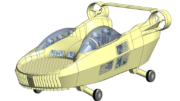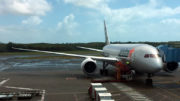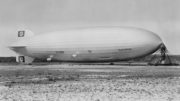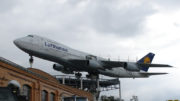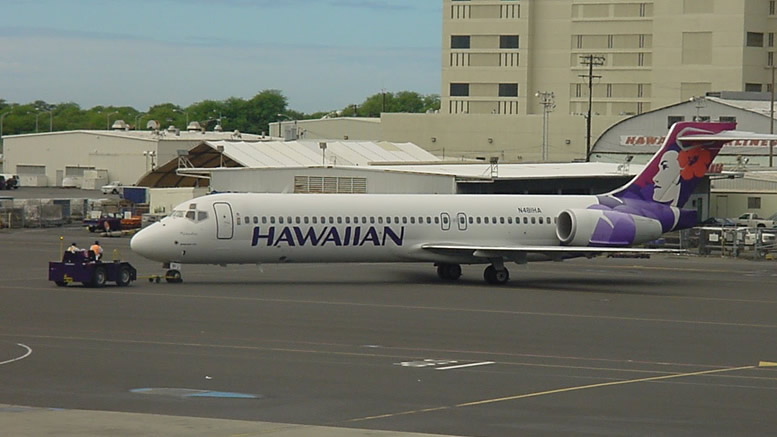 The twinjet Boeing 717 is Boeing Company’s smallest commercial airliner. It entered service in September 1999, making it one of the newest airliners on the market, and yet one of the oldest – the 717 is a renamed McDonnell Douglas MD-95, which itself was based on the venerable Douglas DC-9 that first flew in 1965.
The twinjet Boeing 717 is Boeing Company’s smallest commercial airliner. It entered service in September 1999, making it one of the newest airliners on the market, and yet one of the oldest – the 717 is a renamed McDonnell Douglas MD-95, which itself was based on the venerable Douglas DC-9 that first flew in 1965.
The last third of the 20th century had been a difficult one for aircraft manufacturers. The one-time undisputed market leader Douglas, faced with declining sales of its DC-8 line and stiff competition from the Boeing 737 for its DC-9, found the task of financing the planned wide-body trijet DC-10 beyond its means and was forced to merge with military specialist McDonnell in 1967.
Post merger, McDonnell Douglas (MDC) continued to struggle: the DC-8 production line closed in 1972; by chasing the same market niche, the DC-10 and the rival Lockheed Tristar both lost money. Only the DC-9 continued to sell well: almost 1000 were built up to 1982, when it was stretched and renamed the MD-80. Over 1100 MD-80s were delivered through the 1980s and early 1990s, but the follow-on revision, the MD-90, sold poorly, with just 117 made.
MDC had seen off stiff competition from Lockheed in the ’70s (Lockheed withdraw from civil aircraft manufacturing after relatively lacklustre sales of the Tristar), but even with new, fuel-efficient engines and many changes, the MD-90s in the 150 seat class were unable to compete successfully with the similarly sized Airbus A320 and 737.
The all-new A320 first flew in 1988 and rapidly became known for its outstanding operating costs, while Boeing’s “Next-Generation” 737s, although based on a design almost as old as the DC-9, were heavily revised with new Airbus-style electronic cockpits, new, more efficient engines, and a complete new wing. The MD-80 and MD-90 had had a host of detail changes over the years, but could only offer new engines to push its elderly-looking airframe along.
The MD-95 – the aircraft that would eventually become the 717 – was announced in 1991, initially as the MD-87-105, a re-shortened version of the stretched MD-80 family that took it back to about the same size as the DC-9 Series 30 of the 1960s. It was soon renamed “MD-95” to reflect the anticipated first delivery date, but in the event MDC could not find an airline willing to place a firm order to start production against until that time.
In October 1995, US discount carrier ValuJet signed an order for 50 MD-95s, plus 50 options. Generally, new aircraft have one or more large, well-established high-prestige airlines as launch customers. Launching MD-95 production on the basis of a single order from a two-year-old start-up company with doubtful finances was highly optimistic, and seen as a reflection of the difficulty MDC was having selling aircraft.
In December 1996 Boeing made a $13 billion takeover offer for McDonnell Douglas and the merger became official the following year. Boeing was quick to get rid of the entire MDC commercial product line, save only the MD-95, which was re-named the Boeing 717, and (for a short while longer) the freighter version of the MD-11.
Most industry observers expected that the MD-95 would soon be dropped also. To begin with, Boeing had no more success selling the 717 than McDonnell Douglas, and even the original order for 50 was no certainty in the chaotic post-deregulation US airline market – a customer must not only want an aircraft, it must be able to pay for it. (In the event, ValuJet, now known as AirTran, would meet with considerable success and is now operating 70 DC-9 family aircraft, including 53 717s.)
Boeing took a handful of small orders from leasing companies and minor operators, and a second large order, for 50 717s from TWA, but following the dramatic slump in airline traffic caused by reaction to the September 11th terrorist attacks in the USA, Boeing announced a review of the type’s future.
After much deliberation, it was decided to proceed. Despite the lack of orders, Boeing had confidence in the 717s fundamental suitability to the 100-seat market, and in the long-term size of that market. Additionally, the former Douglas plant at Long Beach was almost idle – besides the 717s, there was only a handful of C-17s to keep it busy. Perhaps most importantly of all, dropping the 717 would mean abandoning the 100-seat market to arch-rival Airbus and their planned A318: from a marketing point of view, any airline that bought A318s would have a powerful reason to then buy A320s and A321s instead of 737s to take advantage of common parts and crewing. Previous to the Airbus A318 and 717 most airlines bought planes like the British Aerospace BAe-146 to fill the void in the 100 seat market.
Many airlines that have purchased the 717 have become converts to the type. It is roomier and faster than the British Aerospace BAe-146, cheaper to operate, and has achieved an outstanding dispatch reliability of 99.6%. Maintenance costs are very low: a check C inspection, for example, takes just three days and is required only once in 4500 flying hours. (For comparison, the old DC-9, which was always well-regarded by engineering departments for its fuss-free nature, needed 21 days for a check C.) The new Rolls Royce BR715 engine design is highly modular: none of the line replaceable units takes more than an hour to exchange, and about a third of them can be changed in under 15 minutes. Boeing claims a better than 10% operating cost advantage over the A318.
After 19 worldwide 717 sales in 2000, and just 6 in 2001, Boeing took 32 717 orders in 2002, despite the massive industry downturn.
The 100-seat market was overcrowded until 2001, but several potential competitors have disappeared. BAe cancelled their Avro RJX (an updated BAe 146 with modern engines); Fairchild Dornier closed their doors, taking the 728/928 project with them, and Bombardier cancelled their new BRJ in favour of a less ambitious stretched 90-seat CRJ.
The remaining players are Boeing themselves, Airbus with the A318, and Embraer with the ERJ 195. The existing worldwide fleet is largely made up of aging twinjets with relatively high operating costs, notably the DC-9, early model 737s, and the Fokker 100, plus the newer four-engined BAe 146, which is a prime prospect for refurbishment.
Bowing recently announced that production of the 717 will cease in 2006. Boeing’s CEO claimed “the overall market for the airplane does not support continuing 717 production beyond delivering on our current commitments”. Boeing also have plans to upgrade their 737 pane design that can fill the 100 to 215 seat market more effectively.

